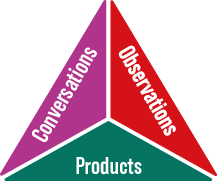F1. Money and Finances
Demonstrate the knowledge and skills needed to make informed financial decisions.
Learning Situation: The Family is Moving to Canada!
Duration: approximately 150 minutes
Overview
In this learning situation, students will demonstrate factors that come into play when a family moves to Canada. They will demonstrate the knowledge and skills necessary to make informed financial decisions such as using exchange rates for currency conversion, determining reliable sources of information that can help the family plan and achieve their financial goal, and determine the influence that certain social and personal factors may have on financial decision-making. Finally, students will explain the difference between a savings account and an investment account.
|
Overall Expectation |
Specific Expectations |
|
Financial Literacy F1. Demonstrate the knowledge and skills necessary to make informed financial decisions. |
F1.1 Identify and compare exchange rates, and convert foreign currencies to Canadian dollars and vice versa. F1.2 Identify and describe various reliable sources of information that can help with planning for and reaching a financial goal. F1.4 Identify various societal and personal factors that may influence financial decision making, and describe the effects that each might have. F1.5 Explain how interest rates can impact savings, investments, and the cost of borrowing to pay for goods and services over time. |
| Preferred High-Impact Instructional Practices in Mathematics | Description |
|---|---|
|
Learning Goals, Success Criteria and Descriptive Feedback |
Before beginning this learning activity, it is essential to make the learning goals, based on the curriculum expectations and content, explicit so that they are known and understood by all students. This will ensure that students are aware of the learning goals of the lesson. The success criteria can then be developed and understood through a variety of instructional strategies, such as using examples of student work, co-constructing the success criteria, or self-assessing how the criteria have been met. These strategies allow for student engagement and a shared understanding of the steps needed to achieve the learning goals. It is important to make the learning goals and success criteria visible by posting them in the classroom for students to refer to throughout the lesson. Descriptive feedback related to the criteria provides the specific information students need to achieve the intended learning goals. By providing descriptive feedback on multiple occasions, educators help students develop the skills to assess their own learning and reflect on the criteria. In this learning situation, a good time for descriptive feedback is during the Active Learning phase. Students are presented with a complex real-life situation that includes such elements as factors influencing financial decision making, currency conversion, identifying reliable sources of information, and choosing a type of account. Students work and communicate in small groups, and, with thoughtful questioning, educators check for understanding and direct students to the criteria to adjust or justify their work. During the Review phase, some solutions may require descriptive feedback from the educator to ensure that the student has the necessary support to revise their thinking to apply to a new context. |
|
Problem-Solving Tasks and Experiences |
This learning situation, where students must analyze the factors that come into play when a family moves to Canada and must make informed financial decisions, is a problem-solving experience, since it gives students the opportunity to reason, communicate, represent, make connections, and justify thinking. This learning situation has many entry points, and all students will be able to participate and propose solutions using their strategies, as well as their critical and creative thinking. This approach promotes accessibility for all students and the exchange of a variety of mathematical strategies and ideas. This learning situation can be differentiated by using different numbers for the work teams (smaller numbers for a less complex exercise or larger numbers for a more complex exercise), making the task accessible yet challenging for the students. |
|
Math Conversations |
By planning lessons like this, which emphasize collaboration and groupwork, the math conversations are ongoing. These conversations allow students to express themselves and react to the mathematical ideas presented. The role of educators will be to ask open-ended, thought-provoking questions to stimulate thinking and allow for multiple responses. This interaction through questioning must be carefully planned to highlight key concepts, skills, or specific representations to promote student progress. Educators are encouraged to anticipate students' questions and answers in order to make the exercise even more strategic (for example, by anticipating some common errors). As soon as the learning situation begins, educators should ask questions that are accessible to all students and encourage them to share their ideas in the class group. As students are engaged in solving the problem, questioning and discussion should promote their reasoning and justification as a group and develop their critical thinking. During Review, the questioning should support rich mathematical conversation in the whole group and provide educators with the opportunity to assess student understanding of the concepts being learned. |
| Prior Knowledge and Skills | |
|
To be able to complete this learning situation, students must be able to:
|
|
Learning Goals
At the end of this learning situation, the student will be able to:
- Convert foreign currencies into Canadian dollars.
- Identify and describe reliable sources of information in order to make a sound financial decision.
- determine how various social and personal factors can influence financial decision making.
- Explain how interest rates can affect savings and investing over time.
Possible Success Criteria Based on the Achievement Chart
|
Skill |
Success Criteria |
|---|---|
|
Knowledge and Understanding |
The student demonstrates an understanding of the exchange rate from one currency to another and compares them. The student identifies various sources of reliable information in order to plan and achieve a financial goal. The student identifies factors that can influence financial decision making. The student demonstrates an understanding of interest rates for different accounts (savings and investment) offered by a financial institution. |
|
Thinking |
The student selects strategies to calculate the exchange rate from one currency to another and solves problems involving interest rates for a savings account and an investment account. The student evaluates a variety of reliable sources of information. The student interprets solutions to problems according to the context presented. The student selects data to formulate persuasive arguments and make informed decisions. The student assesses personal, family, cultural, and social factors that may influence financial decision making. The student assesses how interest rates can affect savings and investment over time. |
|
Communication |
The student justifies their choices with mathematical evidence, while using the conventions and terminology under study. |
|
Application |
The student calculates the exchange rates of different currencies. The student calculates interest rates for a savings account and an investment account. |
Materials
- calculators
- paper
- internet access for research
- Appendix (Setting the Scene)
Mathematical Vocabulary
currency, exchange rate, interest rate, loan, mortgage, goods, services, financial institution, savings, investment
Before Learning (Warm-Up)
Duration: 30 minutes
Assessment can be carried out through…
Display the following images:

 image Drawings of various representations:A man carries giant coins. A calculator, a pair of glasses.A pile of coins and wads of banknotes. A huge piggy bank in the shape of a pig. A woman sits on the piggy bank with her computer, and a child slips a giant coin into the slot. Another child climbs the piggy bank with a ladder.
image Drawings of various representations:A man carries giant coins. A calculator, a pair of glasses.A pile of coins and wads of banknotes. A huge piggy bank in the shape of a pig. A woman sits on the piggy bank with her computer, and a child slips a giant coin into the slot. Another child climbs the piggy bank with a ladder.
Facilitate a discussion by asking questions such as:
- What words do the images make you think of?
- What do you think people need to think about when they move?
- What do you think people need to think about when they move to another country?
- Are you familiar with the currencies of any other country? How is it different from Canadian currency?
- When you want to buy something, can you research the best brand? How do you decide if the information you find comes
from a reliable source? - What does "investing" mean?
- Why would anyone want to invest?
- What is the difference between short-term and long-term investing?
Active Learning (Exploration)
Duration: 60 minutes
Assessment can be carried out through…
Present the scenario below to the students:
Tristano and his family live in Italy. After a long reflection, the family decides to move to Canada, more specifically to Toronto, Ontario, where they have a lot of family. It takes a lot of planning.
- What factors do you think may have influenced their decision to move to Canada? Justify your answers.
- The father decides to take a trip to Toronto to look for a job and a house for their family. They have 900 euros and must change them into Canadian dollars before their big trip. How many Canadian dollars will they be able to receive for their 900 euros with today's exchange rate?
- For the purchase of a house, the father must consult reliable sources of information. In your opinion, what reliable sources of information should they consult before buying a house?
- Tristano's father needs to find a Canadian financial institution to deposit $5000 for Tristano's post-secondary education. Should they open a savings account or an investment account? Justify your reasoning.
Note: Because students have different experiences and financial situations at home, it is important to encourage "I" talk. Some discomfort may be felt by students who cannot afford, for example, to invest in their post-secondary education. It is the educator's responsibility to ensure that all students can relate to the situation.
Make sure that the students understand the task by asking questions such as:
- Who can describe the task in their own words?
- What data is relevant in this situation?
Ask students to present and justify their solutions during the mathematical exchange.
Form teams of two or three students.
Provide students with the necessary materials.
Allow enough time for students to complete the task.
Circulate in the classroom and observe the strategies used by the students. Provide support as needed to help some teams
progress by asking scaffolded questions, such as:
| Possible Observations | Possible Interventions |
|---|---|
| The team has difficulty recognizing useful information. |
|
| The student has difficulty identifying the information needed to solve the problem. |
|
Possible Answers
- Several factors could influence their decision to move to Canada.
- Economic factor - Tristano's father or mother may have lost their jobs due to economic changes in their region of Italy.
There may be more opportunities in Canada for jobs in their field. - Family factor – The family may want to be closer to their relatives in Toronto.
- Social factor – The family lives in a small community in Italy. In Toronto, the family would have access to much more
socialization and services. - Cultural factor – This is a new adventure for Tristano's family as they discover a new lifestyle.
- Economic factor - Tristano's father or mother may have lost their jobs due to economic changes in their region of Italy.
- Tristano's father has to convert 900 euros into Canadian dollars.
In order to determine the current exchange rate, I do an Internet search. Currently, the exchange rate is \(1 \ \mathrm{EUR} = 1.32 \ \mathrm{CAD}\)
I multiply 900 by the current exchange rate.
\begin{align} 1 \ \mathrm{EUR} &= 1.32 \ \mathrm{CAD} \\ 900 \ \mathrm{EUR} &= \ ? \ \mathrm{CAD} \\ &= 900 \times 1.32 \\ &= 1184.53 \ \mathrm{CAD} \end{align}
Tristano's father will receive $1184.53 Canadian as a result of the currency conversion.
- Tristano's father can consult a few reliable sources of information to help him in the purchase of a house:
- A financial institution to find out about interest rates on a mortgage loan.
- A real estate agent who knows the area in which he would like to buy a house and who has a good reputation.
- Real estate agency websites to find homes that are for sale in the desired neighbourhood and the price of those homes.
- Family members who live in the desired neighbourhood and who are familiar with the advantages and disadvantages of houses for sale.
- I need to calculate the interest based on the interest rates for a savings account and an investment account for the amount of $5000.
Duration Savings Account, 4% Annual Interest Long Term Investment, 10% Annual Interest 1 year $5000 × 4% = $200
$5000 + $200 = $5200
$5000 × 10% = $500
$5000 + $500 = $5500
2 years $5200 × 4% = $208
5200 + $208 = $5408
$5500 × 10% = $550
$5500 + $550 = $6050
3 years $5408 × 4% = $216.32
$5408 + $216.32 = $5624.32
$6050 × 10% = $605
$6050 + $605 = $6655
Since this money is for Tristano's post-secondary education, the investment account is the most beneficial with a 10% interest rate. Since the investment account has big advantages over the savings account, it should be seriously considered. This type of account is for long-term financial goals. The savings account is for short-term financial goals.
The investment account can better help the family achieve their long-term financial goals of helping to pay for Tristano's post-secondary education, provided they consider the inability to access these funds for the duration of the investment.
Ask the teams to compare their results with those of another team.
Invite teams to post their work.
Review
Duration: 60 minutes
Assessment can be carried out through…
Ask the students to share their solution with the class and explain the strategies used to determine the factors that may have influenced Tristano’s family’s decision to move and to determine currency conversion, reliable sources of information, and the best type of investment for Tristano’s studies.
Ask students to contribute to the discussion and enrich their mathematical conversations by asking questions to check their understanding.
If necessary, ask questions based on the content of the posted work:
- Do you think you have represented the problem correctly?
- Is your solution logical? Does your solution make sense? Why?
- Do all teams have the same answer? Why?
- Do you feel you have met the learning goals?
- What do you think were the advantages (or disadvantages) of working in a team? Do you know of any strategies that can improve collaboration between team members and group effectiveness?
Following the discussions, ensure that the student:
- Demonstrates an understanding of the concepts of exchange rates and interest rates.
- Recognizes reliable sources of information that can influence financial decision making.
- Recognizes the personal, family, cultural and social factors that can influence financial decision making.
- Recognizes the difference between the interest rate on a savings account and an investment account and the impact over time.
Consolidation of Learning
- Create an infographic to appropriately represent the impact of various interest rates on investments.
- Watch the exchange rates during the week to see the fluctuation and discuss factors that may influence this fluctuation.
- Invite students to do the same learning situation, but imagine moving from Canada to another country of their choice.
Links to Other Curriculum Expectations
Number
B2.2 Understand and recall commonly used percents, fractions, and decimal equivalents.
B2.3 Use mental math strategies to increase and decrease a whole number by 1%, 5%, 10%, 25%, 50%, and 100%, and explain the strategies used.
Algebra
C2.3 Solve equations that involve multiple terms, whole numbers, and decimal numbers in various contexts, and verify solutions.
Differentiated Instruction and Universal Design for Learning
- Provide websites to facilitate currency conversion, for example: Currency Converter – Bank of Canada
- Provide a single interest rate to the student to determine the impact on savings.
- With the student or a group of students, break down the task into steps to organize the work to be done. For example, think
about the factors that influenced the move, find the exchange rate of euros, and find reliable sources of information to consult when buying a house.
For an Extra Challenge
- Invite students to research and compare the average price of homes in various Canadian cities. Ask them to determine if Tristano's family should consider moving to a city other than Toronto and to justify their reasoning.
- Depending on the chosen city, invite students to include research about financial institutions and the accounts offered.
